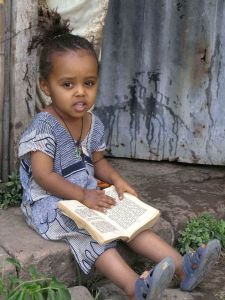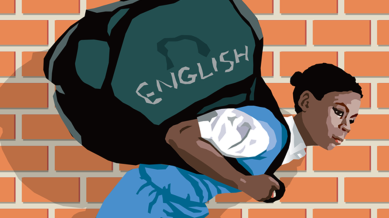The day broke with an atmosphere charged with sweltering heat. The dilapidated dingy mud classroom is packed with young women and men. The sweating sticks the skin while the star around which the earth orbits makes ovens on parking lots. There is an easy banter between the teacher and her fellow students. Her mouth tense, her eyes red-rimmed with suffering in her flamboyant dress as she sat enthroned like Queen Victoria. They are talking about their dreams, about jobs and potential. They smile at each other and tease with up-front confidence.
 Like many public secondary schools in the Eastern Cape Province, Grahamstown public schools have continued to perform badly. Statistics has proven that in 2013, the public schools in the district performed third worst in the province in matric exams. However, in the following year, the pass rate increased from 50% in 2013 to 60% because of decline in learner numbers. The Eastern Cape has 6 063 schools across 254 cities and towns, hence having the second highest percentage of learners that did not pay school fees (81%) in 2013, according to Statistics South Africa. Reports show that the main reason provided for the decline in learner numbers by both genders was because of no money for school fees. Despite the school fees issue according to the Eastern Cape learner educator census data (2013) forgotten schools of Eastern Cape are left to rot.
Like many public secondary schools in the Eastern Cape Province, Grahamstown public schools have continued to perform badly. Statistics has proven that in 2013, the public schools in the district performed third worst in the province in matric exams. However, in the following year, the pass rate increased from 50% in 2013 to 60% because of decline in learner numbers. The Eastern Cape has 6 063 schools across 254 cities and towns, hence having the second highest percentage of learners that did not pay school fees (81%) in 2013, according to Statistics South Africa. Reports show that the main reason provided for the decline in learner numbers by both genders was because of no money for school fees. Despite the school fees issue according to the Eastern Cape learner educator census data (2013) forgotten schools of Eastern Cape are left to rot.
Taking into account that Grahamstown is a former frontier town hence disparate education during the apartheid still, echoes in the provision of public secondary education. Therefore race remains a stark dividing line across the city’s schools. Research found that there are high poverty levels in the city which were caused by the post-1994 economic planning. This economic planning made certain geographic areas of the country more worthy of investment than others and Eastern Cape fell under the less worthy of investment areas. Meaning if you cannot pay for your schooling in Grahamstown you receive less efficient education. Of which 73% of the Eastern Cape is a rural area where people are miners and earn barely enough for survival. One can safely say the parents cannot afford to send their children to private secondary schools and some to just send them to a public school is a struggle hence poverty circle continues.
 Tolweni Senior Secondary school in rural Mount Fere being one of the schools which did not make it on any government or corporate list has more than 1 300 pupils, but 24 teachers. Students are overcrowded in the mud classrooms with inadequate furniture, text books, no electricity nor running water and bad toilets. During community engagement I took part in at Ntsika secondary school I interviewed a grade 12 pupil to find out from her opinion, what the reason was behind poor performance. The pupil, who did not want to be mentioned, informed me that they are taught all subjects in their native language (isiXhosa) of which all subject examination except the home language come in English hence they tend to fail because they do not understand the English. In the English latest Educator’s Association Professor Wright said, ‘’where South African people come face to face with their own character and willingness to work together to construct a progressive, non-racial, non-sexiest democracy that has the capabilities and skills to create a more equal and better resourced society.
Tolweni Senior Secondary school in rural Mount Fere being one of the schools which did not make it on any government or corporate list has more than 1 300 pupils, but 24 teachers. Students are overcrowded in the mud classrooms with inadequate furniture, text books, no electricity nor running water and bad toilets. During community engagement I took part in at Ntsika secondary school I interviewed a grade 12 pupil to find out from her opinion, what the reason was behind poor performance. The pupil, who did not want to be mentioned, informed me that they are taught all subjects in their native language (isiXhosa) of which all subject examination except the home language come in English hence they tend to fail because they do not understand the English. In the English latest Educator’s Association Professor Wright said, ‘’where South African people come face to face with their own character and willingness to work together to construct a progressive, non-racial, non-sexiest democracy that has the capabilities and skills to create a more equal and better resourced society.
Dr. Ashley Westaway the manager of Gadra poses a question whether the failure lies within the students or the system. According to Westaway at the beginning of the year, 40 grade 11 learners progressed to grade 12. This meant that they had already failed in that level; despite failing grade 11 they had still been promoted to grade 12. However, these schools are regarded as dysfunctional not just defined by what they lack, but what they serve since there is also a slow age per grade within schools in the Province. Also, the district director of education Mr. AT Fetsha recently partnered with General Motors South Africa foundation which conducts peace lessons program in life skills teaching grades 4 to 6 which has gradually improved pass rates in the district. Dr. Ashley’s foundation has become beacon of hope to pupils who failed matric and those yet to be in grade 12, as it has opened doors to quality learning so to combat the education crisis in Grahamstown. According to Professor Wright, the state of South African education system shows that it is currently failing to meet the challenge of creating a better resourced society.
Education levels in South Africa have increased from 1990’s. The matric pass rate which was as low as 40% in the late 90’s, continues to improve each year, reaching 76,2% in 2016 without progressed pupils from 74% last year (2015).
